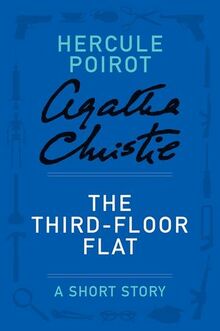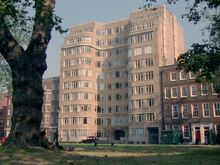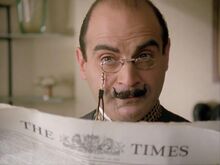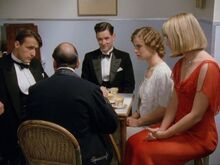
The Third Floor Flat is a short story by Agatha Christie which was first published in Detective Story Magazine in the U.S. and in the Hutchinson's Magazine in the U.K., both in January 1929. In the U.S., the story was gathered and included in the collection Three Blind Mice and Other Stories, published by Dodd, Mead and Company in the U.S. in 1950. In the U.K., the story was not anthologized until it was included in Poirot's Early Cases in 1974.
Synopsis[]
Poirot investigates a murder that hits close to home after the new occupant of a flat two floors below his is found shot.
Plot summary[]
(may contain spoilers - click on expand to read)
Four young people, two women and two men, are returning after a night out to the home of one of the women – Patricia Garnett. She is annoyed as she cannot find the key to her flat on the fourth floor of her apartment block in her handbag. The porter doesn't have a spare key, nor is there a fire escape, but the suggestion is made that the two men, Donovan Bailey and Jimmy Faulkener, make their way up through the coal lift and let the women in.
They go to the basement and make their way up. Exiting the lift, they find the kitchen in darkness and Donovan instructs Jimmy to remain where he is while he locates the light switch. He does so but the light fails to work and Donovan makes his way through the dark to the sitting room. He switches on that room's light and they suddenly realise that they have miscounted the floors and that they are in the flat below which, according to a pile of letters, seems to belong to a Mrs Ernestine Grant. They make their way up to the next floor again via the coal lift and let Pat and the second lady, Mildred Hope, into the former's flat. It is then that they notice that Donovan has cut himself as there is blood on his hand. He washes it off but cannot find a cut to explain the blood and voices his fears to Jimmy. Again using the coal lift, they return to Mrs Grant's flat below and soon spot a foot sticking out from under a curtain – it is the dead body of Mrs Grant. Back on the landing with the girls, they are discussing calling the police when a voice interrupts them, agreeing with their plan of action. It is the occupant of the fifth floor flat who introduces himself as Hercule Poirot, the famous detective that the four people have heard of. Going into Mrs Grant's flat, Poirot finds it curious that the light switch in the kitchen now works. He also sees that the red tablecloth disguises a patch of blood – it is this that Donovan touched to get the blood on his hand. The body was moved after death.
The police arrive and Hercule Poirot and the four people go back to Pat's flat where she makes them a much appreciated omelette. Inspector Rice questions them and tells them that Mrs Grant was shot with an automatic pistol some five hours earlier in the kitchen. They have found a note from someone signed "J.F." saying that he would be there at half-past-seven (the approximate time of death), the pistol she was shot with and a silk handkerchief used to wipe the prints from the gun and which is named "John Fraser". Poirot is suspicious – why would the murderer wipe his prints and yet leave his own handkerchief as evidence behind?
The police leave but the Inspector gives Poirot permission to inspect the flat himself. He goes down there with Donovan and Jimmy. He immediately starts to search in the kitchen bin and soon finds a small bottle. He sniffs the corked top carefully but says that he has a cold and Donovan impetuously pulls the stopper out and sniffs the contents for him. The results are almost immediate – Donovan drops in a faint. Jimmy fetches his friend a drink and Donovan recovers and decides to go home.
Jimmy remains and Poirot tells him the case is solved. There is no such person as John Fraser as the letter and handkerchief were put there in purpose to hide the murderer's identity. The bottle in the bin was a ruse which Donovan fell for – it contained ethyl chloride and Poirot placed it there when he was apparently searching the bin. When Jimmy was getting the drink for his friend, Poirot searched Donovan's pockets and found two things – Pat's missing flat key which Donovan had abstracted earlier in the evening and a letter sent to Mrs Grant which arrived by the late evening post. Poirot had been struck by the fact that the light switch in the kitchen supposedly didn't work when later on there seemed nothing wrong with it. Donovan needed to get Jimmy out of the kitchen into the other room whilst he found the letter he was so desperately searching for and if he switched the light on in the kitchen as soon as they arrived in the coal lift he wouldn't have had the opportunity as their "mistake" in counting the floors would instantly have been noticed.
The letter is from a firm of solicitors agreeing that the marriage between Donovan Bailey and Ernestine Grant some eight years before in Switzerland was entirely lawful. Donovan wanted to marry Pat but his previous marriage was stopping him. By chance his first wife moved into the same block as his proposed future wife and was threatening to tell Patricia about their marriage. To stop her, Donovan killed her earlier in the evening but had to return for the solicitor's letter which he knew was on the way but which had not yet arrived.
Characters[]
- Hercule Poirot
- Patricia Garnett
- Donovan Bailey
- Jimmy Faulkener
- Mildred Hope
- Ernestine Grant
- Inspector Rice



Research notes[]
- Poirot lived in the building. He had taken the unit under the name of "O'Connor". The text states the name as "Friar Mansions" and not Whitehaven Mansions which Poirot lived in later.
- Omelettes - Poirot says he has "a passion for omelettes". Patricia Garnett made a good omelette for him which he praised. He tells Patricia that he once loved a beautiful young English girl who looked like her, but she could not cook. In Mrs McGinty's Dead, Poirot teaches Maureen Summerhayes to make an omelette. In Cat Among the Pigeons, Julia Upjohn confirmed that Maureen made "smashing omelettes" to which Poirot replied that since he had taught her to cook them, "Poirot not lived in vain."
- According to the text, the building has five storeys. Poirot lives on the fifth floor. He says he likes to be at the top.
- Jimmy says that "a building of five storeys ought to have a fire escape". He also says that Patricia's flat is on the fourth floor. We know Poirot lived above her. From this, it is likely that Christie was using the American floor numbering convention. By the British (and European) convention, a fourth floor would be the top of a five storey building because the first storey street level is called Ground and one above is the first floor. Poirot could not be above her in this case. This story was first published in the U.S. and Christie likely did not want to confuse her readers and so used the American convention.
- Although this is considered one of Poirot's early cases, the text notes that Inspector Rice treated him with "reverence". Patricia calls him "The M. Poirot! The great detective?" This all suggests that by this time Poirot had achieved a certain fame.
Film, TV, or theatrical versions[]
Agatha Christie's Poirot[]
A television film with David Suchet as Poirot was produced as episode 5 of Series 1 of the ITV series Agatha Christie's Poirot, first broadcast on 5 February 1989. The adaptation is mostly faithful to the original story.
Publication history[]
- 1929: Detective Story Magazine, Volume 106 Number 6 (New York), 5 January 1929 (as In the Third Floor Flat).[1]
- 1929: Hutchinson's Magazine, Volume 21 Number 1 (London), January 1929.[2]
- 1930: Best Detective Stories of the Year 1929, Faber and Faber, 1930.[3]
- 1930: Best English Detective Stories of 1929,Horace Liveright, 1930.
- 1942: Ellery Queen's Mystery Magazine, vol. 3 no.3, Jul 1942.
- 1944: Best Stories from Ellery Queen’s Mystery Magazine, ed. Ellery Queen, Detective Book Club, 1944
- 1949: 14 Great Detective Stories, Howard Haycraft (ed.) Modern Library, 1949.
- 1950: Three Blind Mice and Other Stories, Dodd Mead and Company (New York), 1950
- 1958: Suspense (UK), vol. 1 no. 5, Dec 1958.
- 1974: Poirot's Early Cases, Collins Crime Club (London), September 1974, Hardcover, 256 pp; ISBN 0-00-231312-X
- 1975: Ellery Queen's Mystery Magazine, vol. 65 no. 3, whole no. 376, Mar 1975.
- 1979: Masterpieces of Mystery: The Grand Masters Up to Date, ed. Ellery Queen, Davis, 1979
- 1982: Great Short Tales of Mystery and Terror,Readers Digest, 1982.
- 1989: Mystery,Houghton Mifflin, 1989.
References[]
- ↑ See this listing at Galactic Central
- ↑ See this listing at Galactic Central
- ↑ David Morris, “Insight: Forgotten Anthologies & Christie's The Third Floor Flat & S.O.S.,” CollectingChristie.com, last modified 24 Aug 2021, URL.
